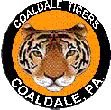Part 1. |
Part 2. |
SOURCE: History of Coaldale - Re-printed from Joseph H. Zerbey History of Pottsville and Schuylkill County, Pennsylvania. As published in Full in “Pottsville Republican” and “Pottsville Morning Paper,” 1934, J.H. Zerbey Newspapers Inc., Print, Pottsville, Pa. |
SOURCE: History of Coaldale - Re-printed from Joseph H. Zerbey History of Pottsville and Schuylkill County, Pennsylvania. As published in Full in “Pottsville Republican” and “Pottsville Morning Paper,” 1934, J.H. Zerbey Newspapers Inc., Print, Pottsville, Pa. |
SOURCE: History of Coaldale - Re-printed from Joseph H. Zerbey History of Pottsville and Schuylkill County, Pennsylvania. As published in Full in “Pottsville Republican” and “Pottsville Morning Paper,” 1934, J.H. Zerbey Newspapers Inc., Print, Pottsville, Pa. |
| SOURCE: History of Coaldale - Re-printed from Joseph H. Zerbey History of Pottsville and Schuylkill County, Pennsylvania. As published in Full in “Pottsville Republican” and “Pottsville Morning Paper,” 1934, J.H. Zerbey Newspapers Inc., Print, Pottsville, Pa. NOTE: “The Senior Class, 1934, of the Coaldale High School, gathered this material under the direction of Wilbur E. Berger, of the Social Science Department. It was written by the same students as an English project under the direction of Oscar S. Keebler, head of the English Department. Committees were appointed to do the research work, and the students responsible for each particular phase of the borough’s history will be noted as the matter is printed.” COALDALE - SCENIC BEAUTY (Committee: Eleanor Livingood, Miriam Jones, Gwen Lewis) Coaldale and environs, in the year 1871, constituted as beautiful a sight as one might wish to see. It nestled between two beautiful mountains, Pitch Mountain and Sharp Mountain. Pitch Mountain, situated north of Coaldale, was covered with oak and maple trees, with an odd pine here and there. Sharp Mountain, situated south of Coaldale, was also called Pine Mountain because most of it was closely grown with pine trees. It had an odd oak tree growing on the summit here and there. Underneath the pine trees grew mountain grass. This was dotted with bushes of baby laurel which grew about a foot high and which bore flowers of a deep rose color. It was also thickly grown with huckleberry and elderberry bushes which were intermixed with rhododendrons. On the east end of Sharp Mountain was a large ice cave where people procured ice to preserve their food. The ice was said to be pure, which is the reason for its being used so extensively. Everybody procured their own ice when they needed it. It was carried to and fro in dishpans, buckets, etc. The cave remains to this day, but it is condemned, because it is undermined. However, the ice is just as abundant as ever and is just as good. East of Coaldale was situated a large forest consisting of pine and spruce trees which grew tall and stately. It was a great recreation center where the schools and churches held most of their picnics. West of Coaldale was a large amusement park called Manila Grove. It received its name from the battle of Manila which was fought about the time the park was opened. Manila Grove was developed by the Eastern Pennsylvania Traction Co. The park contained many amusements. In the park grew many ok and pine trees together with a berry called the “haw” which the people frequently picked. The berry was the fruit of the hawthorne bush, and at that time was considered very palatable. Due to the frequent pickings, this berry has become almost extinct. On the east exit of Manila Grove was a most gorgeous array of mountain laurel which covered the western part of Coaldale. The color of these flowers was rose. They were the size of a full grown peony, with a background of mountain grass which made one think they were mounted on green velvet. They were so pretty that people came on excursions (when transportation was possible) to pick the laurel and see the beautifule picture they presented. The laurels were sent to New York to the sick and unfortunate who otherwise would never have had the opportunity of seeing them. Because of these laurels, the hill was called Laurel Hill. The hill extended east as far as Fifth St., and west as far as Seventh St. It also extended north as far as Ruddle St., and as far south as Lehigh St. At the foot of this hill, a spring cut its way down into the creek. This spring, used as a water spout by the inhabitants of Coaldale, was a great gathering place as it was the only place for the people of Coaldale to obtain water. The previous paragraphs describe the scenery before it was marred by the coal industry. |
